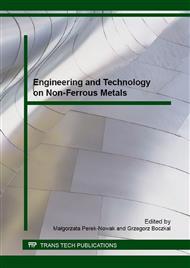p.119
p.125
p.132
p.138
p.143
p.151
p.160
p.171
p.177
Computer-Assisted Methods of the Design of New Materials in the Domain of Copper Alloy Manufacturing
Abstract:
The design of a new copper alloy to obtain material characterized by the expected mechanical properties requires experiments, which enable testing the influence of different processing techniques (e.g. heat treatment operations) on the investigated material. This work consumes both time and money, and hence is a real obstacle in situations, when the researcher has limited resources for preparing and testing only a couple of copper alloy samples. The process of design and testing of a new copper alloy can be speeded up by the use of computing methods, which can be helpful especially in the prime choice of material and its processing technique. The, investigated in this work, methodologies have been chosen from the domain of Artificial Intelligence allowing for a specific nature of the experimentally obtained data, which is usually incomplete in respect of the whole knowledge concerning the studied phenomena. Application of data mining techniques (the theory of rough sets and algorithms of rules or decision trees induction) enable constructing a knowledge base as a set of rules expressing the influence of different processing techniques on mechanical properties of the tested material. Case-based reasoning (CBR), as a methodology focused on the solution of problem together with sustained learning, enables us to build an advisory system giving advice on material design and learning on experimentally obtained results. The data mining techniques and CBR methodology complement each other – the data mining techniques allow generalization of knowledge related to the performed experiments, while CBR uses knowledge in the form of individual experimental items (cases).
Info:
Periodical:
Pages:
143-150
Citation:
Online since:
February 2016
Price:
Сopyright:
© 2016 Trans Tech Publications Ltd. All Rights Reserved
Share:
Citation:


